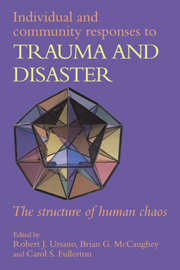Book contents
- Frontmatter
- Contents
- List of contributors
- Foreword
- Preface
- Part I Introduction
- Part II The nature of traumatic stress
- Part III The role of psychosocial context in responses to trauma and disasters
- Part IV Responses to trauma across the life cycle
- 13 Children of war and children at war: child victims of terrorism in Mozambique
- 14 Stress and coping with the trauma of war in the Persian Gulf: the hospital ship USNS Comfort
- 15 Long-term sequelae of combat in World War II, Korea and Vietnam: a comparative study
- 16 Psychophysiological aspects of chronic stress following trauma
- 17 Individual and community reactions to the Kentucky floods: findings from a longitudinal study of older adults
- Part V Conclusions
- Index
17 - Individual and community reactions to the Kentucky floods: findings from a longitudinal study of older adults
from Part IV - Responses to trauma across the life cycle
Published online by Cambridge University Press: 13 October 2009
- Frontmatter
- Contents
- List of contributors
- Foreword
- Preface
- Part I Introduction
- Part II The nature of traumatic stress
- Part III The role of psychosocial context in responses to trauma and disasters
- Part IV Responses to trauma across the life cycle
- 13 Children of war and children at war: child victims of terrorism in Mozambique
- 14 Stress and coping with the trauma of war in the Persian Gulf: the hospital ship USNS Comfort
- 15 Long-term sequelae of combat in World War II, Korea and Vietnam: a comparative study
- 16 Psychophysiological aspects of chronic stress following trauma
- 17 Individual and community reactions to the Kentucky floods: findings from a longitudinal study of older adults
- Part V Conclusions
- Index
Summary
In June 1981, south-eastern Kentucky experienced serious and widespread flooding. Losses amounted to over nine million dollars and, despite the sparse population of the area, over 500 families were left homeless for varying periods of time. In May 1984, a storm system brought tornadoes, strong winds, and severe, extensive flooding to this same area. More than 6000 homes were damaged and over 5000 persons were forced out of their homes by the flooding. The losses, totalling over 20 million dollars, prompted a presidential disaster declaration.
What impact did these two floods have upon their rural Appalachian victims? Were these individuals able to take these events ‘in stride’ or did they present a serious challenge to their ability to cope? Did these floods leave a lasting impact upon the mental and physical wellbeing of these individuals or did they only result in relatively minor and short-lived emotional upset? Were some people more affected than others? What was the impact on the community as a whole? Were these communities able to ‘rally around’ their members or were they shattered and split apart? Did daily life in the community ‘bounce back’ to normal in a few weeks or was the sense of community irreparably altered? These questions and others were the focus of our study of the psychosocial impact of the Kentucky floods.
A considerable body of scientific literature has examined the impact of such disasters on the mental and physical health of victims.
- Type
- Chapter
- Information
- Individual and Community Responses to Trauma and DisasterThe Structure of Human Chaos, pp. 378 - 400Publisher: Cambridge University PressPrint publication year: 1994
- 16
- Cited by



